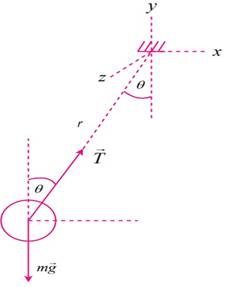
Concept explainers
(a)
To Calculate:
The horizental component of
(a)
Answer to Problem 74P
Explanation of Solution
Given data:
Mass of the ball is
Formula Used:
Angular momentum:
Where,
Newton’s second law of motion:
Where, m is the mass and a is the acceleration.
Calculation:

By the expression of the angular momentum of the ball about the point of support as
Then, by applying Newton’s second law to the ball to get
And
Now, eliminate
By substituting the
Then solve for the velocity of the ball
Substitute numerical values to get
Express the position vector of the ball as
Find the velocity of the ball:
Evaluate for
Substitute for
Substitute into equation
Therefore, the horizontal component of angular momentum
And the vertical component of angular momentum
Conclusion:
(b)
To Calculate:The magnitude of the torque exerted by gravity about the point of support.
(b)
Answer to Problem 74P
Explanation of Solution
Given data:
From the previous part:
Formula Used:
The magnitude of the torque exerted by gravity about the point of support as
Calculation:
By differentiating the angular momentum:
Therefore, the magnitude of above derivative
Substitute the values:
Conclusion:
Torque exerted by gravity about the point of support is
Want to see more full solutions like this?
Chapter 10 Solutions
Physics for Scientists and Engineers
- For a particle traveling in a straight line, are there any points about which the angular momentum is zero? Assume the line intersects the origin.arrow_forwardA uniform rod of mass 200 g and length 100 cm is free to rotate in a horizontal plane around a fixed vertical axis through its center, perpendicular to its length. Two small beads, each of mass 20 g, are mounted in grooves along the rod. Initially, the two beads are held by catches on opposite sides of the rod’s center, 10 cm from the axis of rotation. With the beads in this position, the rod is rotating with an angular velocity of 10.0 rad/s. When the catches are released, the beads slide outward along the rod. (a) What is the rod’s angular velocity when the beads reach the ends of the rod? (b) What is the rod’s angular velocity if the beads fly off the rod?arrow_forwardA solid cylinder of mass 2.0 kg and radius 20 cm is rotating counterclockwise around a vertical axis through its center at 600 rev/min. A second solid cylinder of the same mass and radius is rotating clockwise around the same vertical axis at 900 rev/min. If the cylinders couple so that they rotate about the same vertical axis, what is the angular velocity of the combination?arrow_forward
- Can you assign an angular momentum to a particle without first defining a reference point?arrow_forwardA thin rod of length 2.65 m and mass 13.7 kg is rotated at anangular speed of 3.89 rad/s around an axis perpendicular to therod and through its center of mass. Find the magnitude of therods angular momentum.arrow_forwardThe position vector of a particle of mass 2.00 kg as a function of time is given by r=(6.00i+5.00tj), where r is in meters and t is in seconds. Determine the angular momentum of the particle about the origin as a function of time.arrow_forward
- Show that when A+B=C then A2+B2+2ABcos , where is the angle between vectors A and B .arrow_forwardFigure 13.24 shows a particle with momentum p. Using the coordinate systems shown, determine the direction of the angular momentum of the particle around the origin in each case, and write expressions for L, using symbols defined in Figure 13.23. FIGURE 13.24arrow_forwardA space probe is fired as a projectile from the Earths surface with an initial speed of 2.00 104 m/s. What will its speed be when it is very far from the Earth? Ignore atmospheric friction and the rotation of the Earth. P11.26 Ki+Ui=Kf+Uf12mvi2+GMEm(1rf1ri)=12mvf212vi2+GME(01RE)=12vf2orvf2=v122GMEREandvf=(v122GMERE)1/2,vf=[(2.00104)21.25108]1/2m/s=1.66104m/sarrow_forward
- The velocity of a particle of mass m = 2.00 kg is given by v= 5.10 + 2.40 m /s. What is the angular momentumof the particle around the origin when it is located atr= 8.60 3.70 m?arrow_forwardA particle with mass m and position vector r moves under a force F U = c) What is the radial distance r, as a function of ? km |r|³ a) Give the u-equation in terms of the constant k, the mass m, and the angular momentum (about the z-axis) h. d0² r = ∙er, where k is a positive constant. b) Give the solution for this differential equation, under the condition that at 0 = 0, u = a and - m du de b.arrow_forwardA particle of mass m is under the central force created by the potential energy U(r)=A*r (A>0). The angular momentum of the particle is L (L is not equal to zero). For E=(4/3)E0, find the maximum radial kinetic energy in terms of (r0 and E0). Hint is given in the figurearrow_forward
 Physics for Scientists and Engineers: Foundations...PhysicsISBN:9781133939146Author:Katz, Debora M.Publisher:Cengage Learning
Physics for Scientists and Engineers: Foundations...PhysicsISBN:9781133939146Author:Katz, Debora M.Publisher:Cengage Learning Classical Dynamics of Particles and SystemsPhysicsISBN:9780534408961Author:Stephen T. Thornton, Jerry B. MarionPublisher:Cengage Learning
Classical Dynamics of Particles and SystemsPhysicsISBN:9780534408961Author:Stephen T. Thornton, Jerry B. MarionPublisher:Cengage Learning University Physics Volume 1PhysicsISBN:9781938168277Author:William Moebs, Samuel J. Ling, Jeff SannyPublisher:OpenStax - Rice University
University Physics Volume 1PhysicsISBN:9781938168277Author:William Moebs, Samuel J. Ling, Jeff SannyPublisher:OpenStax - Rice University Principles of Physics: A Calculus-Based TextPhysicsISBN:9781133104261Author:Raymond A. Serway, John W. JewettPublisher:Cengage Learning
Principles of Physics: A Calculus-Based TextPhysicsISBN:9781133104261Author:Raymond A. Serway, John W. JewettPublisher:Cengage Learning



